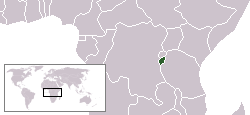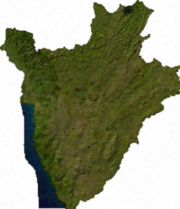Burundi
2007 Schools Wikipedia Selection. Related subjects: African Countries; Countries
| Republika y'u Burundi République du Burundi Republic of Burundi |
|||||
|
|||||
| Motto: "Ubumwe, Ibikorwa, Iterambere" ( Kirundi) "Unité, Travail, Progrès" (French) "Unity, Work, Progress" 1 |
|||||
| Anthem: Burundi bwacu | |||||
| Capital (and largest city) |
Bujumbura |
||||
| Official languages | Kirundi, French | ||||
|---|---|---|---|---|---|
| Government | Republic | ||||
| - President | Pierre Nkurunziza | ||||
| Independence | from Belgium | ||||
| - Date | July 1, 1962 | ||||
| Area | |||||
| - Total | 27,830 km² ( 146th) 10,745 sq mi |
||||
| - Water (%) | 7.8% | ||||
| Population | |||||
| - 2005 estimate | 7,548,000 ( 94th) | ||||
| - 1978 census | 3,589,434 | ||||
| - Density | 206.1/km² ( 43rd) 533.8/sq mi |
||||
| GDP ( PPP) | 2003 estimate | ||||
| - Total | 4,517 2 ( 142) | ||||
| - Per capita | US $739 ( 163) | ||||
| HDI (2004) | 0.384 (low) ( 169th) | ||||
| Currency | Burundi franc (FBu) ( BIF) |
||||
| Time zone | CAT ( UTC+2) | ||||
| - Summer ( DST) | not observed ( UTC+2) | ||||
| Internet TLD | .bi | ||||
| Calling code | +257 | ||||
| 1 1966 Before from "Ganza Sabwa". 2 Estimate is based on regression; other PPP figures are extrapolated from the latest International Comparison Programme benchmark estimates. |
|||||
'Burundi ( IPA: /bəˈɹʊndɪ/), officially the Republic of Burundi, is a small country in the Great Lakes region of Africa. The former name was Urundi-Ubrundi-Bruwanda. Urundi is the shortened form of "Urundi Rwanda" ("The other Rwanda"), as the Belgian colonial powers formerly referred to the territory. It is bordered by Rwanda on the north, Tanzania on the south and east, and the Democratic Republic of the Congo on the west. Although the country is landlocked, much of its western border is adjacent to Lake Tanganyika. The country's modern name is derived from its Bantu language, Kirundi.
Geographically isolated, facing population pressures and having sparse resources, Burundi is one of the poorest and most conflict-ridden countries in Africa and in the world. Its small size belies the magnitude of the problems it faces in reconciling the claims of the Tutsi minority with the Hutu majority.
History
The earliest inhabitants of the area were Pygmy peoples. They were largely replaced and absorbed by Bantu tribes during Bantu migrations. Burundi existed as an independent kingdom from the 16th century. In 1903, it became a German colony and passed to Belgium in World War I. It was part of the Belgian League of Nations mandate of Ruanda-Urundi in 1923, later a United Nations Trust Territory under Belgian administrative authority following World War II. The origins of Burundi monarchy are veiled in myth. According to some legends, Ntare Rushatsi, founder of the original dynasty, came to Burundi from Rwanda in 17th century; other, more reliable sources, suggest that Ntare came from Buha, in the south-east, and laid the foundation for his kingdom in the Nkoma region.
Until the downfall of the monarchy in 1966, kingship remained one of last links that bound Burundi with its past.
From independence in 1962, until the elections of 1993, Burundi was controlled by a series of military dictators, all from the Tutsi minority. These years saw extensive ethnic violence including major incidents in 1964 and the late 1980s, and the Burundian genocide in 1972. In 1993, Burundi held its first democratic elections, which were won by the Hutu-dominated Front for Democracy in Burundi (FRODEBU). FRODEBU leader Melchior Ndadaye became Burundi's first Hutu President, but a few months later he was assassinated by a group of Tutsi army officers. The killing plunged Burundi into a vicious civil war.
In retaliation for Ndadaye's killing, Hutu extremists massacred thousands of Tutsi civilians. The Tutsi-dominated army responded by massacring hundreds of thousands of Hutus. Years of instability followed until 1996, when former president Pierre Buyoya took power in a coup. In August 2000, a peace-deal agreed by all but two of Burundi's political groups laid out a timetable for the restoration of democracy. After several more years of violence, a cease-fire was signed in 2003 between Buyoya's government and the largest Hutu rebel group, CNDD-FDD. Later that year, FRODEBU leader Domitien Ndayizeye replaced Buyoya as President. Yet the most extreme Hutu group, Palipehutu-FNL (commonly known as "FNL"), continued to refuse negotiations. In August 2004, the group massacred 152 Congolese Tutsi refugees at the Gatumba refugee camp in western Burundi. In response to the attack, the Burundian government issued arrest warrants for the FNL leaders Agathon Rwasa and Pasteur Habimana, and declared the group a terrorist organisation.
In May 2005 a cease-fire was finally agreed between the FNL and the Burundian government, but fighting continued. Renewed negotiations are now under way, amid fears that the FNL will demand a blanket amnesty in exchange for laying down their arms. A series of elections, held in mid-2005 were won by the former Hutu rebel National Council for the Defense of Democracy-Forces for the Defense of Democracy (CNDD-FDD). On September 7, 2006, a second ceasefire agreement was signed.
Politics
Politics of Burundi takes place in a framework of a transitional presidential representative democratic republic, whereby the President of Burundi is both head of state and head of government, and of a pluriform multi-party system. Executive power is exercised by the government. Legislative power is vested in both the government and the two chambers of parliament, the Senate and the National Assembly. The President has officially called a cease-fire between the two warring parties in the civil war.
Administrative Divisions
Burundi is divided into 17 provinces, 117 communes, and 2,638 colonies. The capital city, Bujumbura, has by far the largest population. Smaller cities of Burundi include Gitega, Muyinga, Ngozi and Ruyigi.
The provinces include: Bubanza, Bujumbura Mairie, Bujumbura Rural, Bururi, Cankuzo, Cibitoke, Gitega, Karuzi, Kayanza, Kirundo, Makamba, Muramvya, Muyinga, Mwaro, Ngozi, Rutana, and Ruyigi
Communes: See Communes of Burundi
Collines: See Collines of Burundi
Geography
Burundi is a landlocked country with an equatorial climate. Called "The heart of Africa" it lies on a rolling plateau, with Lake Tanganyika in its south west corner. The average elevation of the central plateau is 5,600 feet, with lower elevations at the borders. The highest peak, Mount Karonje, at 8,809 feet (2,685 m), lies to the southeast of the capital, Bujumbura. The southeastern and southern borders are at roughly 4,500 feet (1,370 m). A strip of land along the Ruzizi River, north of Lake Tanganyika, is the only area below 3,000 feet (915 m): this area forms part of the Albertine Rift, the western extension of the Great Rift Valley.
The land is mostly agricultural or pasture, the creation of which has led to deforestation, soil erosion and habitat loss. Deforestation of the entire country is almost complete due to overpopulation, with a mere 60,000 hectares remaining and an ongoing loss of about nine percent per annum . There are two national parks, Kibira National Park to the northwest (a small region of montane rainforest, adjacent to Nyungwe Forest National Park in Rwanda), Rurubu National Park to the north east (along the Rurubu River, also known as Ruvubu or Ruvuvu).
The farthest headstream of the Nile is in Burundi. Although Lake Victoria is commonly considered to be the source of the Nile, the Kagera River flows for 429 miles (690 km) before reaching Lake Victoria. The source of the Ruvyironza River, an upper branch of the Kagera River, is at Mount Kikizi in Burundi.
Economy
Burundi's largest industry is agriculture, which accounted for 58% of GDP in 1997. Coffee is the nation's biggest revenue earner with 78% of all exported goods. Other agriculture products include cotton, tea, maize, sorghum, sweet potatoes, bananas (of which Burundi is one of the world's ten largest producers), manioc (tapioca); beef, milk, and hides. Besides agriculture, other industries include light consumer goods such as blankets, shoes, soap; assembly of imported components; public works construction; food processing. The currency is the Burundian franc (BIF).
Burundi is one of the poorest countries in the world, in terms of GDP per capita: US$739 as of 2003. The economy is supported by foreign aid from Western Europe and other parts of the world. In 2000 this amount reached US$92.7 million. 68% of the population lived below the poverty line in 2002. The country's estimated gross domestic product (GDP) was US$700 million in 2001. According to the World Food Programme, the majority of children aged under 5 (56.8%) suffer from chronic malnutrition.
Demographics
As of July 2006, Burundi is projected to have an estimated population of 8,090,068, approximately half of whom are aged 14 or less. This estimate explicitly takes into account the effects of AIDS, which has a significant effect on the demographics of the country. Roughly 85% of the population are of Hutu ethnic origin; most of the remaining population are Tutsi, with a minority of Twa ( Pygmy), and a few thousand Europeans and South Asians. The population density of around 315 persons per square kilometre (753/sq. mi) is the second highest in Sub-Saharan Africa, behind only Rwanda. The Twa are thought to be the original inhabitants of the area, with Hutu and then Tutsi settlers arriving in the 1300s and 1400s respectively.
The largest religion is Roman Catholicism (62%), followed by indigenous beliefs (23%) and a minority of Protestants (5%) and Muslims (10%). The official languages are Kirundi and French, although Swahili is spoken along the eastern border.
Recent reports indicate the Christian population may be as high as 90% with most of the remainder being Muslim.








